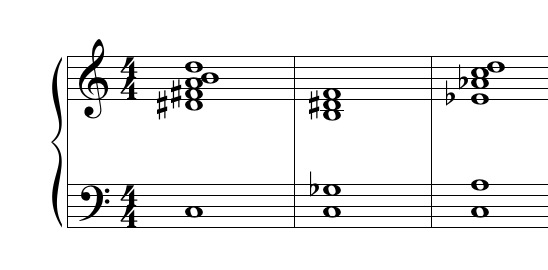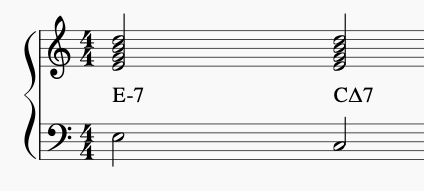<hi @Tuomo your answer is more about the diminished chords
but about the diminished scales and how to use it , to think it .
thanks a lot
<hi @Tuomo your answer is more about the diminished chords
but about the diminished scales and how to use it , to think it .
thanks a lot
Hello Pierre,
Thanks for your thoughtful questions regarding diminished chords and scales. @Tuomo gave some very good answers. I believe that you should play the good voicings that were suggested, plus a few other possible combinations. Remember, because of the nature of diminished chords, you can add major and minor triads that share a relationship to the root based on the scale. For instance, over a C diminished 7 chord, you can add the following major triads: D, F, Ab, B. You can also add the same tones as minor triads, and also the same tones as major or minor 6th tetrads (such as D6, Dm6, F6, Fm6, etc…) This opens up so many possibilities for chord voicing, improvising, arranging, etc. See here for some interesting suggestions of voicings for Cdim7:

I also suggest that you study the music of Antonio Carlos Jobim, as he was a master of using diminished chords in many beautiful contexts.
Thanks for your questions, and keep playing!
Jovino
Hi @pierre,
I would not separate scales and chords from each other, as they are 100% the same thing, for example that dim chord above had all the notes from the scale.
Can I give you an assignment?
To understand diminished chord/scale function, we have to detect the dominant behind it.
Here assignment:
What dominant/dominants can be behind the following dim chord (they work as a part of the harmony):
In the key of C:
Let me know when you solve the puzzle 
Thank you so much for writing!!
Awesome voicings, and thank you for pointing out Jobim 
Also Jovino mentioned the major triads inside the diminished chord, in Cdim would be D, F, Ab, B. Now if you remember the lessons on the 4 dominants that derive from the dim chord, there they are! D7, F7, Ab7 and B7
I would have an extra question for the students about the voicings Jovino sent, which triads can you detect inside the voicings?
i would think first Eb7#9 as tritone substitution of A7 but not the 7th in it ,
so maybe more D7b9
Very good @Pierrot,
it has nothing to do with the Eb7, the key again is to find the dominant, and you are right, D7 would be the one!
The reason why Ebdim resolves to D-7 well is that the D7 is the dominant to G, in this case G7, and the D-7 is the II of the D-7 G7 II V.
Also from Ebdim you can find B7, Ab7 and F7, which can also be used to resolve to the D-7 G7 II V.
Cdim7 resolving to Cmaj.
Also explain why it resolves easily.
-Tuomo
B
B7b9 but the harmonic reason ? i dont know more than B naturally tend to go to C, as F to E in the the progression V7 to I of C
Good thinking, the reason why B7 resolves nicely to Cmaj7 is because Cmaj7 is the same thing as E-7:

And of course B7 is the V of E-7. That is why B7 is very easy and natural to resolve to Cmaj7.
-Tuomo
Wow so easy i even dont think about it
Thanks a lot
Sorry to insist but please give some example how to apply diminished scales on a major and minor 251
i have learn the 3 half whole scale with Hayden and trying to connect it with diminished still make me headache for applying it .
in your video about diminished at 2’34 on 251 you play on a D diminished chord the D diminished so it sound ok but you subtitute Dm7 to Dm7b5 so we need to do the same when playing on 251 major and applying the diminished scale right ?
thanks a lot for your help
Lagging behind you guys trying to get my head around some of this stuff.  I came across this which is in part related. Here’s a link to videos recorded of Barry Harris at his numerous workshops at the Royal Conservatory in The Hague from 1989 till 1998. He covers a bit of everything, including diminished scales. There’s a lot to pick through, but his humorous style is worth the effort. There’s one about feeling the “and” that is interesting for his comments about how jazz was always dance music, but now it’s changed:. It’s pretty long. Most are from 2 to 15 minutes.
I came across this which is in part related. Here’s a link to videos recorded of Barry Harris at his numerous workshops at the Royal Conservatory in The Hague from 1989 till 1998. He covers a bit of everything, including diminished scales. There’s a lot to pick through, but his humorous style is worth the effort. There’s one about feeling the “and” that is interesting for his comments about how jazz was always dance music, but now it’s changed:. It’s pretty long. Most are from 2 to 15 minutes.
Here’s the link to all the videos:
Hi @Pierrot,
If you want to use diminished scale over a 25, it doesn’t matter wether the 25 is minor or major, you would be using the same Ddim scale (D E F G Ab Bb B C#)
You can think of the diminished chord/scale as another color over 25 you can use while improvising.
Let’s look at the minor 25 in C, D-7b5 is the same chord as F-6:
and the G7 would probably have for example b9 and b13 to make it sound more like going to a Cminor. So, we know that G7b9b13 is the same chord as Ab-6:
we see again that all these minor chords, D-, F- and Ab- are minor 3rd away from each other, diminished connects them.
Here’s a lesson on the subject of the minor 3rd relationship, not quite about diminished but very much connected to diminished:
I hope this helps,
let me know if you have any further questions,
-Tuomo
thanks Scott for this wonderful link
Pierre and Tuomo,
Here’s a 52 page study of Harris exploring the diminished that I found on the internet. If you work through it, it should keep you occupied for a good while. 
WOW  thats look great ! Thanks so much !
thats look great ! Thanks so much !
I can only see the audio files. Maybe it’s because I’m on an iPad
Yes, it’s using some sort of framing code that isn’t supported by the iPad.
Sounds like some kind of bug.
Images should definitely be accessible on all devices.
I’ll email our tech guy for the forum.
Leave it with me and I’ll get it fixed asap. 
-Tuomo